weight VAUXHALL COMBO E 2020 Owner's Manual
[x] Cancel search | Manufacturer: VAUXHALL, Model Year: 2020, Model line: COMBO E, Model: VAUXHALL COMBO E 2020Pages: 279, PDF Size: 28.6 MB
Page 50 of 279
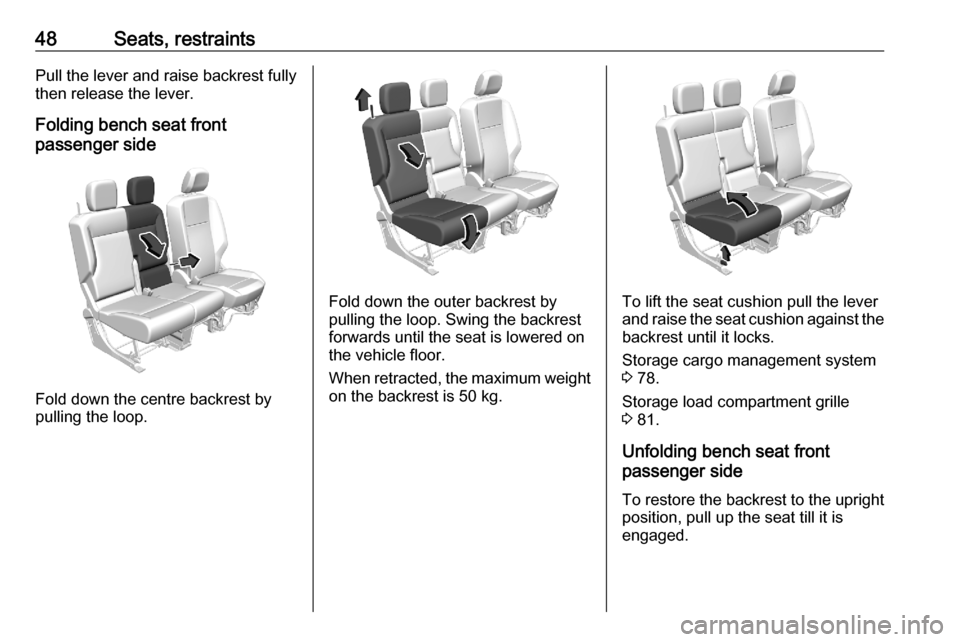
48Seats, restraintsPull the lever and raise backrest fully
then release the lever.
Folding bench seat front
passenger side
Fold down the centre backrest by
pulling the loop.
Fold down the outer backrest by pulling the loop. Swing the backrestforwards until the seat is lowered on
the vehicle floor.
When retracted, the maximum weight
on the backrest is 50 kg.To lift the seat cushion pull the lever
and raise the seat cushion against the backrest until it locks.
Storage cargo management system
3 78.
Storage load compartment grille
3 81.
Unfolding bench seat front
passenger side
To restore the backrest to the upright position, pull up the seat till it is
engaged.
Page 66 of 279
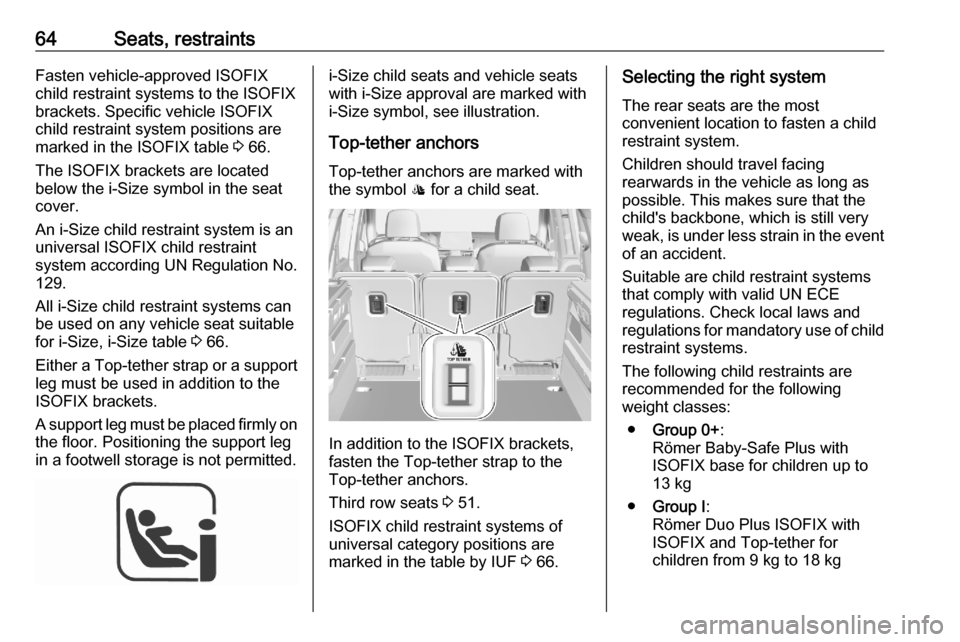
64Seats, restraintsFasten vehicle-approved ISOFIX
child restraint systems to the ISOFIX
brackets. Specific vehicle ISOFIX
child restraint system positions are
marked in the ISOFIX table 3 66.
The ISOFIX brackets are located
below the i-Size symbol in the seat
cover.
An i-Size child restraint system is an universal ISOFIX child restraint
system according UN Regulation No. 129.
All i-Size child restraint systems can
be used on any vehicle seat suitable
for i-Size, i-Size table 3 66.
Either a Top-tether strap or a support
leg must be used in addition to the
ISOFIX brackets.
A support leg must be placed firmly on the floor. Positioning the support leg
in a footwell storage is not permitted.i-Size child seats and vehicle seats
with i-Size approval are marked with i-Size symbol, see illustration.
Top-tether anchors
Top-tether anchors are marked with
the symbol : for a child seat.
In addition to the ISOFIX brackets,
fasten the Top-tether strap to the
Top-tether anchors.
Third row seats 3 51.
ISOFIX child restraint systems of
universal category positions are
marked in the table by IUF 3 66.
Selecting the right system
The rear seats are the most
convenient location to fasten a child
restraint system.
Children should travel facing
rearwards in the vehicle as long as
possible. This makes sure that the child's backbone, which is still very
weak, is under less strain in the event of an accident.
Suitable are child restraint systems
that comply with valid UN ECE
regulations. Check local laws and
regulations for mandatory use of child
restraint systems.
The following child restraints are recommended for the following
weight classes:
● Group 0+ :
Römer Baby-Safe Plus with
ISOFIX base for children up to
13 kg
● Group I :
Römer Duo Plus ISOFIX with
ISOFIX and Top-tether for
children from 9 kg to 18 kg
Page 68 of 279

66Seats, restraintsChild restraint installation locations
Permissible options for fastening a child restraint system with a three-point seat belt
Weight class
On front passenger seatOn outer seats in
the second rowOn centre seat in
the second rowOn seats in the
third rowactivated airbagdeactivated airbagGroup 0, Group 0+: up to 13 kgXU 1,2U3UU 3Group I: 9 to 18 kgUFU1,2U3,4UU3,4Group II: 15 to 25 kgUFU 1,2U3,4UU3,4Group III: 22 to 36 kgUFU1,2U3,4UU3,4U:universal suitability for forward-facing or rearward-facing child restraint systems in conjunction with three-point seat
beltUF:universal suitability for forward-facing child restraint systems in conjunction with three-point seat beltX:no child restraint system permitted in this weight class1:move seat forwards as far as necessary and adjust seat backrest inclination as far as necessary to a vertical position
to ensure that the belt runs forwards from the upper anchorage point2:adjust seat backrest inclination as far as necessary to a vertical position to ensure that the belt is tight on the buckle
side3:move the respective front seat ahead of the child restraint system forwards as far as necessary4:adjust the respective headrest as necessary or remove if required
Page 69 of 279

Seats, restraints67Permissible options for fitting an ISOFIX child restraint system with ISOFIX bracketsWeight classSize classFixtureOn front passenger seatOn the seats in the second
rowOn the seats in the
third rowGroup 0: up to 10 kgG
FISO/L2
ISO/L1
ISO/R1X
X
XX
X
IL 3X
X
XGroup 0+: up to 13 kgEISO/R1XIL 3XDISO/R2XIL3XCISO/R3XIL3XGroup I: 9 to 18 kgDISO/R2XIL3,4XCISO/R3XIL3,4XBISO/F2XIL, IUF 3,4XB1ISO/F2XXIL, IUF3,4XAISO/F3XIL, IUF 3,4XIL:suitable for particular ISOFIX restraint systems of the 'specific-vehicle', 'restricted' or 'semi-universal' categories.
The ISOFIX restraint system must be approved for the specific vehicle type (refer to the vehicle type list of the child restraint system)IUF:suitable for ISOFIX forward-facing child restraint systems of universal category approved for use in this weight classX:no ISOFIX child restraint system approved in this weight class3:move the respective front seat ahead of the child restraint system forwards as far as necessary4:adjust the respective headrest as necessary or remove if required
Page 70 of 279

68Seats, restraintsISOFIX size class and seat deviceA – ISO/F3:forward-facing child restraint system for children of maximum size in the weight class 9 to 18 kgB – ISO/F2:forward-facing child restraint system for smaller children in the weight class 9 to 18 kgB1 – ISO/F2X:forward-facing child restraint system for smaller children in the weight class 9 to 18 kgC – ISO/R3:rear-facing child restraint system for children of maximum size in the weight class up to 18 kgD – ISO/R2:rear-facing child restraint system for smaller children in the weight class up to 18 kgE – ISO/R1:rear-facing child restraint system for young children in the weight class up to 13 kgF– ISO/L1:left lateral facing position child restraint system (carry-cot)G – ISO/L2:right lateral facing position child restraint system (carry-cot)
Permissible options for fitting an i-Size child restraint system with ISOFIX brackets
On front passenger seatOn the seats in the second rowOn the seats in the third rowi-Size child restraint systemsXi - UXi - U:suitable for i-Size 'universal' forward and rearward facing child restraint systemsX:seating position not suitable for i-Size 'universal' child restraint systems
Page 73 of 279
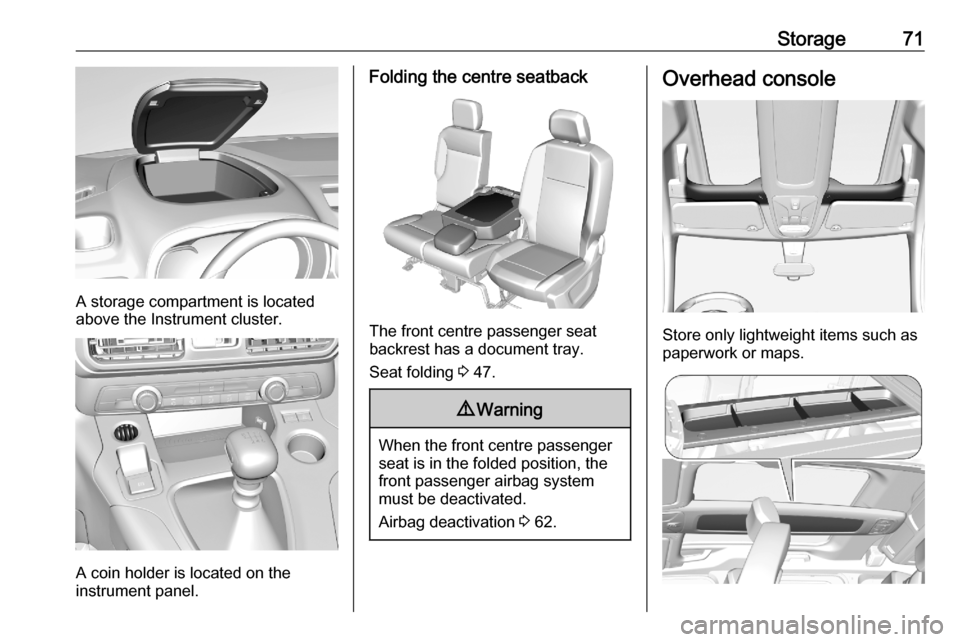
Storage71
A storage compartment is located
above the Instrument cluster.
A coin holder is located on the
instrument panel.
Folding the centre seatback
The front centre passenger seat
backrest has a document tray.
Seat folding 3 47.
9 Warning
When the front centre passenger
seat is in the folded position, the front passenger airbag system
must be deactivated.
Airbag deactivation 3 62.
Overhead console
Store only lightweight items such as
paperwork or maps.
Page 87 of 279

Storage85Mounting points are located at the
bottom of the roof railing.
Fasten the roof rack according to the
installation instructions delivered with
the roof rack.
Vehicles without roof railing
To fasten a roof rack, unscrew the
caps in the roof strips. Insert the
mounting provisions, as instructed, in the retainer.
Loading information
● Heavy objects in the load compartment should be placed
against the seat backrests. Make
sure that the backrests are
securely engaged. If objects can
be stacked, heavier objects
should be placed at the bottom.
● Prevent sliding of loose objects by securing them with straps
attached to the lashing eyes
3 78.
● Do not allow the load to protrude above the upper edge of the
backrests.
● Do not place any objects on the rear luggage cover or the
instrument panel, and do not cover the sensor on top of theinstrument panel.
● The load must not obstruct the operation of the pedals, parking
brake and gear selector, or
hinder the freedom of movement
of the driver. Do not place any
unsecured objects in the interior.
● Do not drive with an open load compartment.9Warning
Always make sure that the load in
the vehicle is securely stowed.
Otherwise objects can be thrown
around inside the vehicle and
cause personal injury or damage
to the load or car.
● The payload is the difference between the permitted gross
vehicle weight (see identification
plate 3 256) and the EC kerb
weight.
Page 88 of 279
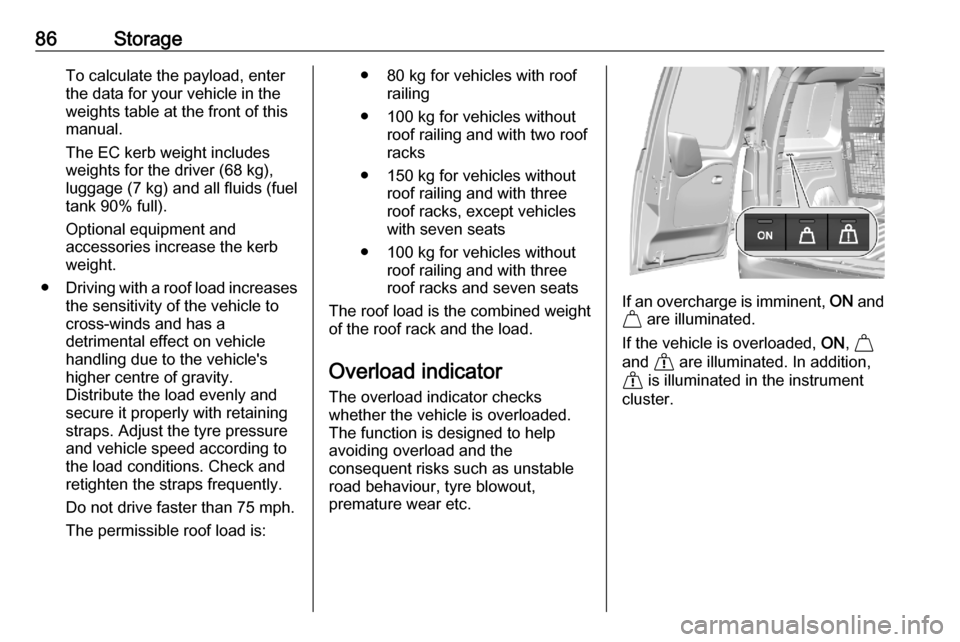
86StorageTo calculate the payload, enter
the data for your vehicle in the
weights table at the front of this
manual.
The EC kerb weight includes
weights for the driver (68 kg),
luggage (7 kg) and all fluids (fuel
tank 90% full).
Optional equipment and
accessories increase the kerb
weight.
● Driving with a roof load increases
the sensitivity of the vehicle to
cross-winds and has a
detrimental effect on vehicle
handling due to the vehicle's
higher centre of gravity.
Distribute the load evenly and
secure it properly with retaining
straps. Adjust the tyre pressure
and vehicle speed according to
the load conditions. Check and
retighten the straps frequently.
Do not drive faster than 75 mph.
The permissible roof load is:● 80 kg for vehicles with roof railing
● 100 kg for vehicles without roof railing and with two roofracks
● 150 kg for vehicles without roof railing and with three
roof racks, except vehicles
with seven seats
● 100 kg for vehicles without roof railing and with three
roof racks and seven seats
The roof load is the combined weight
of the roof rack and the load.
Overload indicator The overload indicator checks
whether the vehicle is overloaded.
The function is designed to help
avoiding overload and the
consequent risks such as unstable
road behaviour, tyre blowout,
premature wear etc.
If an overcharge is imminent, ON and
% are illuminated.
If the vehicle is overloaded, ON, %
and & are illuminated. In addition,
& is illuminated in the instrument
cluster.
Page 106 of 279

104Instruments and controlsAntilock brake system(ABS)
u illuminates yellow.
Illuminates for a few seconds after the
ignition is switched on. The system is ready for operation when the control
indicator extinguishes.
If the control indicator does not
extinguish after a few seconds, or if it
illuminates while driving, there is a
fault in the ABS. The brake system
remains operational but without ABS
regulation.
Antilock brake system 3 159.
Gear shifting
R with the number of a higher gear is
indicated, when upshifting is
recommended for fuel saving
reasons.
Overload indicator
& illuminates.
Illuminates when the overload
indicator detects an exceeding of the
maximum authorised weight 3 86.Descent control system
ò illuminates or flashes green.
Iluminates green The system is switched on and ready
to operate.
Flashes green
The system is in operation.
Lane keep assist
a illuminates green or yellow, or
flashes yellow.
Illuminates green
The system is switched on and ready to operate.
Illuminates yellow
The system approaches a detected
lane marking without using the turn
light in that direction.
Flashes yellow The system recognizes that the lane
is departed significantly.Lane keep assist 3 198.
Electronic Stability Control
and Traction Control system
b illuminates or flashes yellow.
Illuminates
A fault in the system is present.
Continued driving is possible. Driving stability, however, may deteriorate
depending on road surface
conditions.
Have the cause of the fault remedied
by a workshop.
Flashes
The system is actively engaged.
Engine output may be reduced and
the vehicle may be braked
automatically to a small degree.
Electronic Stability Control and
Traction Control system 3 163.
Selective ride control 3 165.
Engine coolant temperature o illuminates red.
Page 167 of 279
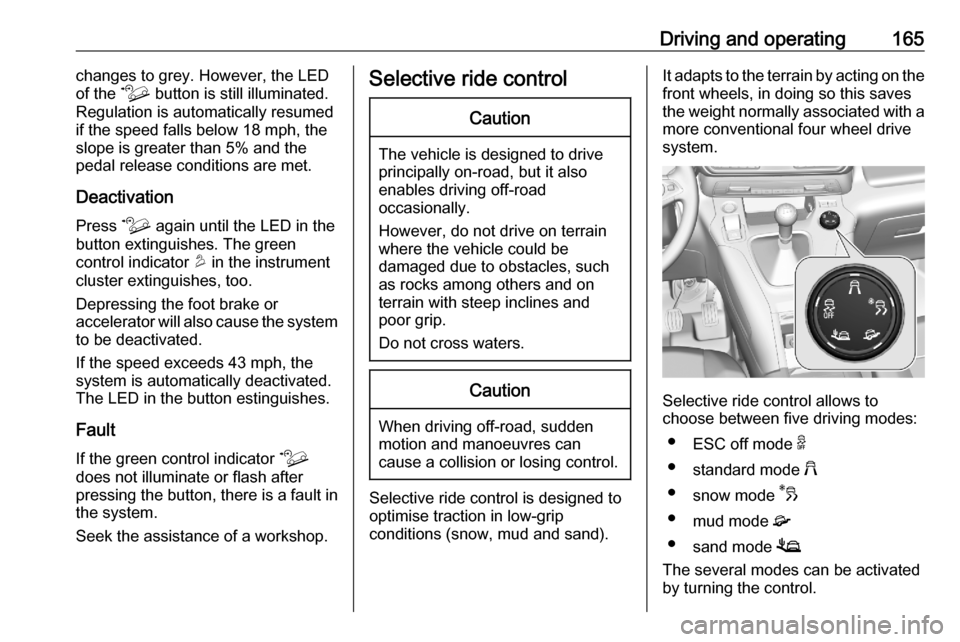
Driving and operating165changes to grey. However, the LED
of the ò button is still illuminated.
Regulation is automatically resumed
if the speed falls below 18 mph, the
slope is greater than 5% and the
pedal release conditions are met.
Deactivation Press ò again until the LED in the
button extinguishes. The green
control indicator u in the instrument
cluster extinguishes, too.
Depressing the foot brake or
accelerator will also cause the system to be deactivated.
If the speed exceeds 43 mph, the system is automatically deactivated.
The LED in the button estinguishes.
Fault
If the green control indicator ò
does not illuminate or flash after
pressing the button, there is a fault in
the system.
Seek the assistance of a workshop.Selective ride controlCaution
The vehicle is designed to drive
principally on-road, but it also
enables driving off-road
occasionally.
However, do not drive on terrain
where the vehicle could be
damaged due to obstacles, such
as rocks among others and on
terrain with steep inclines and
poor grip.
Do not cross waters.
Caution
When driving off-road, sudden
motion and manoeuvres can
cause a collision or losing control.
Selective ride control is designed to
optimise traction in low-grip
conditions (snow, mud and sand).
It adapts to the terrain by acting on the
front wheels, in doing so this saves
the weight normally associated with a more conventional four wheel drive
system.
Selective ride control allows to
choose between five driving modes:
● ESC off mode 9
● standard mode 2
● snow mode 3
● mud mode 4
● sand mode 1
The several modes can be activated
by turning the control.